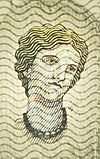Europa (consort of Zeus) facts for kids
Quick facts for kids Europa |
|
|---|---|
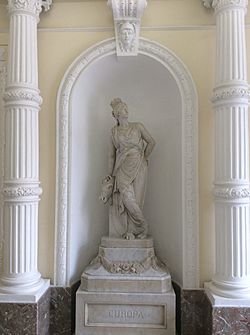
Statue of Europa representing Europe at Palazzo Ferreria
|
|
| Abode | Crete |
| Personal information | |
| Born | Tyre, Phoenicia, (modern-day Lebanon) |
| Consort | Asterion, Zeus |
| Children | Minos, Rhadamanthys, Sarpedon, Crete, Alagonia, Carnus |
| Parents | Agenor with either Telephassa or Argiope; alternatively Phoenix and Perimede |
| Siblings | Cadmus, Cilix, Phoenix |
In Greek mythology, Europa ( Ancient Greek: Εὐρώπη, Eurṓpē) was a Phoenician princess of Argive Greek origin, and the mother of King Minos of Crete. The continent of Europe may be named after her. The story of her abduction by Zeus in the form of a bull was a Cretan story; as classicist Károly Kerényi points out, "most of the love-stories concerning Zeus originated from more ancient tales describing his marriages with goddesses. This can especially be said of the story of Europa."
Europa's earliest literary reference is in the Iliad, which is commonly dated to the 8th century BC. Another early reference to her is in a fragment of the Hesiodic Catalogue of Women, discovered at Oxyrhynchus. The earliest vase-painting securely identifiable as Europa dates from the mid-7th century BC.
Family

Sources differ in details regarding Europa's family, but agree that she is Phoenician, and from an Argive lineage that ultimately descended from the princess Io, the mythical nymph beloved of Zeus, who was transformed into a heifer. She is generally said to be the daughter of Agenor, the Phoenician King of Tyre; the Syracusan poet Moschus makes her mother Queen Telephassa ("far-shining") but elsewhere her mother is Argiope ("silver-faced"). Other sources, such as the Iliad, claim that she is the daughter of Agenor's son, the "sun-red" Phoenix.
After arriving in Crete, Europa had three sons fathered by Zeus: Minos, Rhadamanthus, and Sarpedon, the first two becoming judges of the Underworld, alongside Aeacus of Aegina, when they died. In Crete she married Asterion also rendered Asterius and became mother (or step-mother) of his daughter Crete.
Mythology

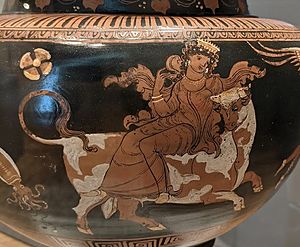
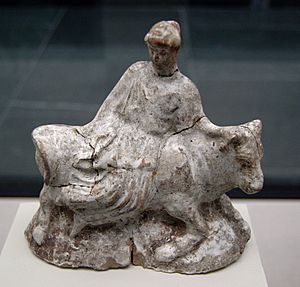
The Dictionary of Classical Mythology explains that Zeus was enamoured of Europa and decided to abduct her. He transformed himself into a tame white bull and mixed in with her father's herds. While Europa and her helpers were gathering flowers, she saw the bull, caressed his flanks, and eventually got onto his back. Zeus took that opportunity and ran to the sea and swam, with her on his back, to the island of Crete. He then revealed his true identity, and Europa became the first queen of Crete. Zeus gave her a necklace made by Hephaestus and three additional gifts: the bronze automaton guard Talos, the hound Laelaps who never failed to catch his quarry, and a javelin that never missed. Zeus later re-created the shape of the white bull in the stars, which is now known as the constellation Taurus. It should not be confused with the Cretan Bull that fathered the Minotaur and was captured by Heracles. Roman mythology adopted the tale, also known as "The Abduction of Europa", substituting the god Jupiter for Zeus.
Namesakes
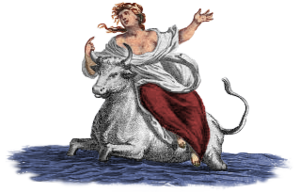
Continent
The name Europe, as a geographical term, was used by Ancient Greek geographers such as Strabo to refer to part of Thrace below the Balkan mountains. Later, under the Roman Empire the name was given to a Thracian province.
It is derived from the Greek word Eurōpē (Εὐρώπη) in all Romance languages, Germanic languages, Slavic languages, Baltic languages, Celtic languages, Iranian languages, Uralic languages (Hungarian Európa, Finnish Eurooppa, Estonian Euroopa).
Jürgen Fischer, in Oriens-Occidens-Europa summarized how the name came into use, supplanting the oriens–occidens dichotomy of the later Roman Empire, which was expressive of a divided empire, Latin in the West, Greek in the East.
In the 8th century, ecclesiastical uses of "Europa" for the imperium of Charlemagne provide the source for the modern geographical term. The first use of the term Europenses, to describe peoples of the Christian, western portion of the continent, appeared in the Hispanic Latin Chronicle of 754, sometimes attributed to an author called Isidore Pacensis in reference to the Battle of Tours fought against Muslim forces.
The European Union has also used Europa as a symbol of pan-Europeanism, notably by naming its web portal after her and depicting her on the Greek €2 coin and on several gold and silver commemorative coins (e.g. the Belgian €10 European Expansion coin). Her name appeared on postage stamps celebrating the Council of Europe, which were first issued in 1956. The second series of euro banknotes is known as the Europa Series and bears her likeness in the watermark and hologram.
Chemical element
The metal europium, a rare-earth element, was named in 1901 after the continent.
Moon of Jupiter
The invention of the telescope revealed that the planet Jupiter, clearly visible to the naked eye and known to humanity since prehistoric times, has an attendant family of moons. These were named for male and female lovers of the god and other mythological persons associated with him. The smallest of Jupiter's Galilean moons was named after Europa.
See also
 In Spanish: Europa (mitología) para niños
In Spanish: Europa (mitología) para niños


